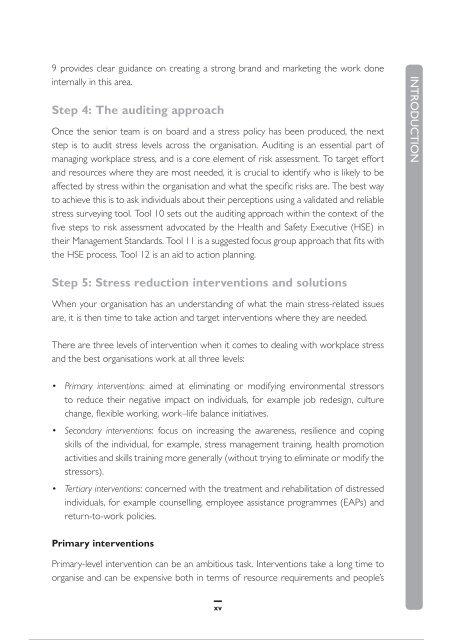Contents - CIPD
Contents - CIPD
Contents - CIPD
Create successful ePaper yourself
Turn your PDF publications into a flip-book with our unique Google optimized e-Paper software.
9 provides clear guidance on creating a strong brand and marketing the work doneinternally in this area.Step 4: The auditing approachOnce the senior team is on board and a stress policy has been produced, the nextstep is to audit stress levels across the organisation. Auditing is an essential part ofmanaging workplace stress, and is a core element of risk assessment. To target effortand resources where they are most needed, it is crucial to identify who is likely to beaffected by stress within the organisation and what the specific risks are. The best wayto achieve this is to ask individuals about their perceptions using a validated and reliablestress surveying tool. Tool 10 sets out the auditing approach within the context of thefive steps to risk assessment advocated by the Health and Safety Executive (HSE) intheir Management Standards. Tool 11 is a suggested focus group approach that fits withthe HSE process. Tool 12 is an aid to action planning.INTRODUCTIONStep 5: Stress reduction interventions and solutionsWhen your organisation has an understanding of what the main stress-related issuesare, it is then time to take action and target interventions where they are needed.There are three levels of intervention when it comes to dealing with workplace stressand the best organisations work at all three levels: Primary interventions: aimed at eliminating or modifying environmental stressorsto reduce their negative impact on individuals, for example job redesign, culturechange, flexible working, work–life balance initiatives. Secondary interventions: focus on increasing the awareness, resilience and copingskills of the individual, for example, stress management training, health promotionactivities and skills training more generally (without trying to eliminate or modify thestressors). Tertiary interventions: concerned with the treatment and rehabilitation of distressedindividuals, for example counselling, employee assistance programmes (EAPs) andreturn-to-work policies.Primary interventionsPrimary-level intervention can be an ambitious task. Interventions take a long time toorganise and can be expensive both in terms of resource requirements and people’sxvA free sample chapter from Stress by Robertson Cooper. Published by the <strong>CIPD</strong>. © 2008 <strong>CIPD</strong>.All rights reserved; no part of this excerpt may be reproduced, stored in a retrieval system, or transmitted in anyform or by any means, electronic, mechanical, photocopying, recording or otherwise without the prior writtenpermission of the publishers or a licence permitting restricted copying in the United Kingdom issued by theCopyright Licensing Agency.If you would like to purchase this product please go to www.cipd.co.uk/bookstore
















